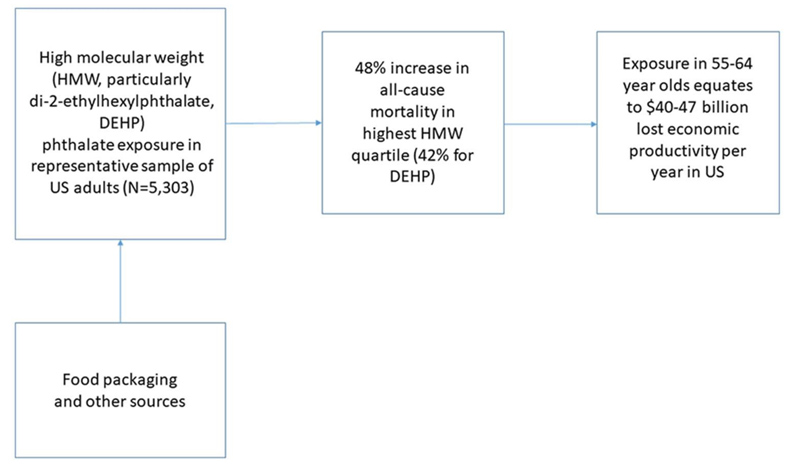Features
Update 2021/10/18
Chemicals
Deaths linked to ‘Hormone Disruptor’ chemical cost billions in lost U.S. productivity
By Suzanne Forcese
Daily exposure to chemicals called ‘phthalates’ aka ‘the everywhere chemicals’, may lead to roughly 90,000-100,000 premature deaths among older Americans each year, a new study shows.
The resulting economic burden is between $40 billion and $47 billion, a value more than quadruple that of previous estimates.
The Study
Peer Reviewed “Phthalates and attributable mortality: A population-based longitudinal cohort study and cost analysis”, Leonard Trasande et al
According to the study, “Accelerating evidence of endocrine-related morbidity has raised alarm about the ubiquitous use of phthalates in the human environment, but studies have not directly evaluated mortality in relation to these exposures.”
Led by researchers at NYU Grossman School of Medicine, the new investigation of more than 5,000 adults between the ages of 55 and 64 showed that those with the highest concentrations of phthalate in their urine were more likely to die of heart disease than those with lesser exposure. The study evaluated associations of phthalate exposure with mortality, and quantified attributable mortality and lost economic productivity.
Highlights
- Phthalate exposures were associated with all-cause and cardiovascular mortality
- Further studies are needed to corroborate observations and identify mechanisms
- Extrapolating to 55–64-year-olds, we identified ≥ 90,000 attributable deaths/year
- The results suggest $39.9-$47.1 billion in lost economic productivity/year Regulatory action is urgently needed
Bottled Water: One example of the phthalate cycle that exposes consumers to phthalates by drinking the water and again by breathing and ingesting the nano plastics when the plastic bottles break down in the environment.
What are phthalates?
Phthalates, (pronounced THAL-eights) are a group of man-made chemical compounds used to make products more flexible and durable. There are 12 billion pounds of phthalates produced worldwide annually.
Because they break down into nanoparticles, they are everywhere in the environment – including our WATER, OUR AIR, OUR FOOD, OUR HOMES.

Phthalates are present in thousands of products, including plastics, solvents, toys, medical devices, food packaging, building materials, household cleaning products, personal care products, shampoos and soaps to preserve fragrance.
Exposure
People are mostly exposed to phthalates by eating foods, drinking water and other beverages that have been in contact with containers and products containing phthalates.
Phthalates are widely used chemicals in the US food system and can enter the food at any point in food processing, packaging and/or preparation (e.g., microwaving).
Inhalation, skin absorption, and intravenous injection are all potential pathways.
Phthalates can be released from a product by heat, agitation, and prolonged storage. The release can occur during all stage of the product lifecycle – from production, through use, to disposal.
Phthalate dust, caused by the breakdown of plastics and other consumer products (either already in the house or tracked indoors on shoes) can cause a dust legacy and be disturbed, resuspended, and circulated.
The Dangers
For decades, phthalates have been shown to pose a potential danger to human health because the chemicals can interfere with the function of hormone signaling compounds made in glands that circulate to influence processes throughout the body.
Exposure is believed to occur through buildup of these toxins as consumer products break down and are ingested, with exposure linked to obesity, diabetes, and heart disease.
“Our findings reveal that increased phthalate exposure is linked to early death, particularly due to heart disease. Until now, we have understood that the chemicals connect to heart disease, and heart disease in turn is a leading cause of death, but we had not yet tied the chemicals themselves to death.” -- Leonardo Trasande, MD, MPP, the Jim G.
Handrick MD, Professor of Pediatrics in the Department of Pediatrics and Professor in the Departments of Environmental Medicine and Population Health
For the investigation, the research team analyzed data including phthalates found in urine samples obtained from adults who participated in the U.S. National Health and Nutrition survey from 2001 to 2010

The researchers limited their analysis to those whose cause of death had been tracked through 2015. In addition, they focused on a subgroup of Americans between 55 and 64 since previous studies had based estimates of phthalate-driven death in this population.
This way the team could accurately compare their study results to the prior estimates.
The study investigators also used data from the U.S. Centers for Disease Control and Prevention Wonder database, the U.S. Census Bureau, and models from earlier studies to estimate the economic cost of early death for this group.
Dr. Trasande cautions that the new study does not establish a direct cause and effect association between phthalate exposure ad early deaths, in part because the specific biological mechanism that would account for the connection remains unclear.
The study investigators plan further research on the role these chemicals may play in hormone regulation and inflammation in the body.
However, according to Trasande, the new results add to mounting evidence of societal costs related to continued heavy exposure to the chemicals. For example, past research has linked more than 10,000 deaths a year to lowered testosterone levels in adult men attributed to phthalate exposure. These deaths cost Americans nearly $9 billion in lost economic productivity.
This new study was designed to further examine links between phthalate exposure and deaths of all causes in the U.S. and quantify the resulting economic costs, according to Trasande.
“Our research suggests that the toll of this chemical on society is much greater than we first thought,” Trasande concludes.
“The evidence is undeniably clear that limiting exposure to toxic phthalates can help safeguard Americans’ physical and financial well-being.”
suzanne.f@watertoday.ca
|